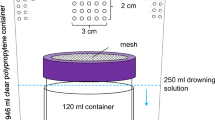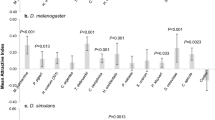Abstract
Attraction to microbial volatiles was examined for the sap beetle, Carpophilus humeralis, which is a pest of maize. Using 54 pure yeast and bacterial cultures, we evaluated differences in volatile emissions among species of microorganisms and whether these differences were associated with insect attraction. On a sterile corn-based medium, both yeasts and bacteria generally multiplied well and produced detectable volatile metabolites. The yeasts ranged from inactive to highly attractive, but no bacterial cultures attracted beetles above control levels. A variety of alcohols, esters, ketones, acids, and phenolic compounds were identified from the headspace above yeast cultures. Growth, volatile production, and, ultimately, attractiveness to beetles depend strongly on the ability of the yeasts to assimilate and/or ferment the carbohydrates present. Abundant volatile production on sweet corn was observed only with yeasts that are able to ferment sucrose and/or maltrose. Saccharomyces cerevisiae (ferments glucose, sucrose, and maltose) and Candida shehatae (ferments glucose and maltose) produced considerably more attractive volatiles than Candida guilliermondii, which only ferments glucose. Yeast volatiles important for beetle attraction included typical fermentation-associated substances (ethanol, acetaldehyde, 2-methyl-1-propanol, 1-propanol, ethyl acetate, 3-methyl-1-butanol and 2-methyl-1-butanol), and also 3-hydroxy-2-butanone, whose presence was not correlated with the occurrence of fermentation. Using aqueous mixtures of synthetic components that produced headspace compositions simulating those of attractive yeasts, it was shown that the typical fermentation volatiles are attractive but not essential for attractiveness. 3-Hydroxyl-2-butanone is sufficient but not necessary, although its attractiveness is enhanced by the presence of fermentation volatiles such as ethanol and 2-methyl-1-proponol. In nature, the beetles could take advantage of a variety of different microbial metabolic processes to locate hosts. The laboratory bioaasays in this study involved flight and therefore were particularly relevant to host-finding behavior in the field.
Similar content being viewed by others
REFERENCES
Alm, S. R., Hall, F. R., Ladd, T. L., Jr., and Williams, R. N. 1985. A chemical attractant for Glischrochilus quadrisignatus (Coleoptera: Nitidulidae). J. Econ. Entomol. 78:839–843.
Alm, S. R., Williams, R. N., McGovern, T. P., and Hall, F. R. 1989. Effective chemical structures, release methods, and trap heights for attracting Glischrochilus quadrisignatus (Coleoptera: Nitidulidae). J. Econ. Entomol. 82:477–481.
Bartelt, R. J. 1997. Calibration of a commercial solid-phase microextraction device for measuring headspace concentrations of organic volatiles. Anal. Chem. 69:364–372.
Bartelt, R. J., Dowd, P. F., Plattner, R. D., and Weisleder, D. 1990. Aggregation pheromone of driedfruit beetle, Carpophilus hemipterus: Wind-tunnel bioassay and identification of two novel tetraene hydrocarbons. J. Chem. Ecol. 16:1015–1039.
Dowd, P. F. 1987. A labor saving method for rearing the driedfruit beetle (Coleoptera: Nitidulidae) on pinto bean-based diet. J. Econ. Entomol. 80:1351–1353.
Kreger-Van Ru, N. J. W. 1984. The Yeasts, A Taxonomic Study, 3rd rev. and enlarged ed. Elsevier Science Publishers, Amsterdam.
Lin, H., and Phelan, P. L. 1991a. Identification of food volatiles attractive to dusky sap beetle, Carpophilus lugubris (Coleoptera: Nitidulidae). J. Chem. Ecol. 17:1273–1286.
Lin, H., and Phelan, P. L. 1991b. Identification of food volatiles attractive to Glischrochilus quadrisignatus and Glischrochilus fasciatus (Coleoptera: Nitidulidae). J. Chem. Ecol. 17:2469–2480.
Lin, H., and Phelan, P. L. 1992. Comparison of volatiles from beetle-transmitted Ceratocystis fagacearum and four non-insect-dependent fungi. J. Chem. Ecol. 18:1623–1632.
Lussenhop, J., and Wicklow, D. T. 1990. Nitidulid beetles (Nitidulidae: Coleoptera) as vectors of Aspergillus flavus in preharvest maize. Trans. Mycol. Soc. Jpn. 31:63–74.
Nout, M. J. R., Platis, C. E. and Wicklow, D. T. 1997. Biodiversity of yeasts from Illinois maize. Can. J. Microbiol. 43:362–367.
Phelan, P. L., and Lin, H. 1991. Chemical characterization of fruit and fungal volatiles attractive to dried-fruit beetle, Carpophilus hemipterus (L.) (Coleoptera: Nitidulidae) J. Chem. Ecol. 17:1253–1272.
Smilanick, J. M., Ehler, L. E., and Birch, M. C. 1978. Attraction of Carpophilus spp. (Coleoptera: Nitidulidae) to volatile compounds present in figs. J. Chem. Ecol. 4:701–707.
Starmer, W. T., Ganter, P. F. and Aberdeen, V. 1992. Geographic distribution and genetics of killer phenotypes for the yeast Pichia kluyveri across the United States. Appl. Environ. Microbiol. 58:990–997.
Wickerham, L. J. 1951. Taxonomy of yeasts. Technical Bulletin No. 1029, United States Department of Agriculture, Washington, D.C.
Author information
Authors and Affiliations
Rights and permissions
About this article
Cite this article
Nout, M.J.R., Bartelt, R.J. Attraction of a Flying Nitidulid (Carpophilus humeralis) to Volatiles Produced by Yeasts Grown on Sweet Corn and a Corn-Based Medium. J Chem Ecol 24, 1217–1239 (1998). https://doi.org/10.1023/A:1022451020013
Issue Date:
DOI: https://doi.org/10.1023/A:1022451020013




